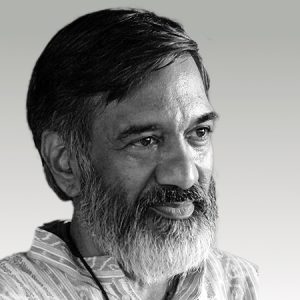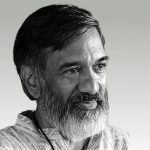
Raghu Ananthanarayanan
Guest is known for...
Raghu is an engineer with an MS in Bio-Medical Engineering. He was mentored by J Krishnamurti, Yogacharya Krishnamacharya, and Pulin K Garg, which transformed him and gifted him the path that he has walked, his sAdhana. He has been involved with the Sumedhas Academy of Human Context since 1995 and Barefoot Academy of Governance since 2012, and his work revolves around helping individuals, groups, and organizations discover their dharma.
Here's what I will learn...
His recent book – 5 Seats of Power – Discovering the best you can be through the Mahabharata – provides thought-provoking frameworks drawn from Indic Wisdom for understanding leadership and culture-building. In our conversation we dig into details around Raghu’s journey and his insights from the book.
LISTEN TO THE FULL CONVERSATION
From the Podcast
Raghu reflects on his childhood and how his grandfather would read the Mahabharata or the Ramayana and also use those stories as an opportunity to share a self-reflective story about their life. He speaks about how this approach might have influenced his style of interacting with people and his teaching approach.
Raghu speaks about some of his choices post his undergraduate degree from IIT Madras. He speaks about how he was influenced by the times he was in and the people he came in touch with (Student Revolutions around the world, Meeting Dharampal etc). He goes on to talk about how Dharampal urged him and some of his friends to spend a decade going deep in a subject before moving on to make a difference.
Raghu speaks about the notion of being Dharmic and how it can be simply defined using three filters – 1) How is it enlivening you? 2) How is it enlivening the person you are interacting with? 3) How is it enlivening the wider context you are in? He goes on to speak about how he has discovered his Dharma in his journey.
Raghu speaks about the distinction between Archetypes and Stereotypes when it comes to relating to some of the historical characters like the Pandavas. He goes on to talk about the defining characteristics of each of the Pandavas and how each one of us might end up having some elements of each of these in us.
Stereotypes when it comes to relating to some of the historical characters like the Pandavas. He goes on to talk about the defining characteristics of each of the Pandavas and how each one of us might end up having some elements of each of these in us.
Raghu speaks about the notion of resolving Dharmasankatas – the double bind situations where there are no easy answers. He speaks about how Indian leadership (going back to King Vikramaditya) has had an emphasis of resolving Dharmasankatas. He goes on to speak about the Leadership traits that help in resolving these tricky situations.
Raghu makes an interesting observation. He says that while Bhagwad Gita was a discussion between Krishna and Arjuna on the various dilemmas the latter was facing, it could have well been a conversation between Krishna and Karna. He says that Karna was so consumed by his hurt that he never even saw the dilemma and that was a missed opportunity. He connects this to several people and communities that might be going through a similar phenomenon.
Raghu expands on the notion of Shantham and calls it the state of quiet high potential but something that’s completely silent. He likens it to someone like a Roger Federer who is in “flow”. He calls it the state where one is fully alert and fully alive and open to all possibilities. He also speaks about how busy leaders can try and access that space of Shantham.
Raghu speaks about the evolving paradigm of leadership and how that’s likely to look like a combination of Arjuna, Nakula and Sahadeva. Yudhishthira and Bheema might possibly be not as relevant as they were in a more predictable past.
Raghu speaks about the distinction between DOING and BEING. He speaks about BEING as a regenerative process, something that heals and nurtures. He also speaks about the need for coherence between what we are doing and who we are being at various points in time and not resolving this is often at the root of what people often describe as a mid-life crisis.
